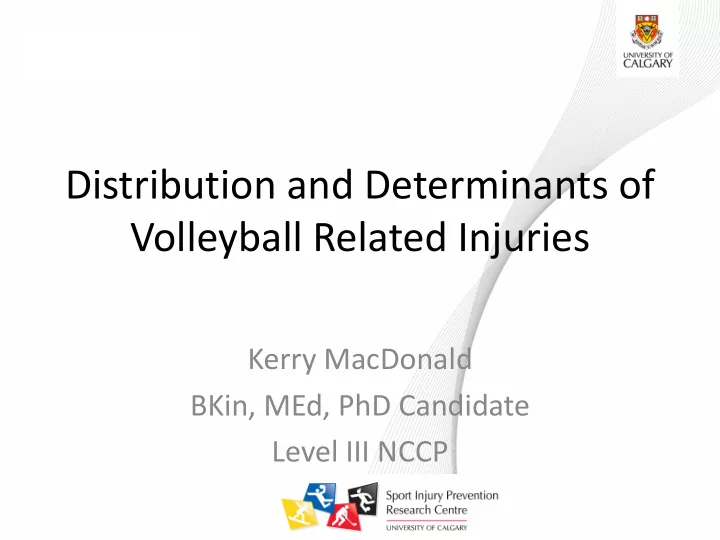

Distribution and Determinants of Volleyball Related Injuries Kerry MacDonald BKin, MEd, PhD Candidate Level III NCCP
• PhD Candidate in Sport Medicine • Sport injury epidemiology - Study of the distribution and determinants of disease/illness within a given population • Sports related injuries are predictable and often preventable • The following is a summation of the current literature.
• Primary • Prevent the injury from ever occurring • Secondary • Early detection, prevention of progression of overuse injuries • Tertiary • Rehabilitation
• Intrinsic • Specific to the athlete • Can be modifiable (Fitness, strength, flexibility, technique) • Or non-modifiable (previous injury, age, gender)
• Extrinsic • Not specific to the athlete, external factors • Can be modifiable (Training Hours, Jump Count) • Or non-modifiable (court surface, ball weight)
Meeuwisse, 2007
• Acute Injuries • Injuries with a specific defining moment of injury. • Fingers and ankles are most common regardless of gender • Concussion rates are unknown
• Overuse Injuries • Injuries that lack an insidious onset. • Most common: Knees, Back, Shoulders • Early symptoms often go unreported as athlete attempt their own self management techniques • Establishment of an open and honest dialogue allows for early detection
40 35 30 25 • 4.6 injuries / 20 15 1000 Hours 10 5 (NCAA) 0 • 1 injury every Most Serious Injuries 14 31 games or 12 10 practices 8 6 4 • 2.7/1000hrs 2 0 d e l l y r l g d l l l l e l r a c a a in AB a e n r a a c n b b k b i b o l c o t c t a c e y e b o o b o D y s e w k S o H C a e l l s F o B t o a a n V k B S S
• The most common predictor of future injury is previous injury • Have a detailed understanding of player’s injury history • Assure full recovery before full return to sport • Err on the side of caution • Secondary injury is often more severe than primary injury
• Type: Acute • Risk Factors: Blocking • Preventative Measures • Equipment: Tape (no evidence) • Coaching: • Teach proper hand position for blocking • Caution when attacking off of boxes
• Type: Acute • Risk Factors: • Intrinsic: Balance • Extrinsic: Attacking and Blocking • Preventative Measures • Equipment: Ankle Braces • Intervention: Balance board training • Coaching: • Reduce tight attack/block interactions • Auto re-serve OR wider centre line
• Risk Factors: • Intrinsic: Balance, Female, Landing Technique • Extrinsic: Attacking and Blocking • Preventative Measures • Equipment: Knee brace (no evidence) • Coaching: • Teach proper landing technique • Reduce tight attack/block interactions • Auto re-serve OR wider centre line
• Landing Technique
• Landing Technique
• Type: Overuse • Risk Factors: • Intrinsic: Jumping ability, ankle ROM, landing technique • Extrinsic: Attacking/Blocking, Jump load, position (OH and Mids) • Preventative Measures • Equipment: Patellar straps/taping
• Coaching • Gradual increases in jump load • Teach “soft” landing technique
• Type: Overuse • Risk Factors: Attacking, Jump Load? • Preventative Measures • Coaching: • Teach arm swing technique with trunk rotation
• Type: Overuse • Risk Factors: Repetitions, Glenohumeral rotational strength difference, Asymmetric pectoral flexibility. • Preventative Measures • Equipment: Thera band • Coaching: • Gradual increases in swing load • Low elbow arm draw?
• Low elbow arm draw? http://prefitpt.com/blog/2013/08/19/the-biomechanics-of-volleyball-the-arm-swing-part-2-2-of-many/
• Type: Acute • Risk Factors: warm-up? • Preventative Measures • Coaching: • Drill and warm-up design to reduce placing athletes in vulnerable positions
• 3.1 injuries per 1000 competition hours (FIVB) • Indoor ~4.6 per • Similar rate of overuse injuries • Back • Knee • Shoulder • Lower rate of acute injuries
• Most Injuries occur during blocking and attacking (acute and overuse) • Be considerate of load change • Reduce risky tight net interactions • The best predictor of future injury is past injury • Know your players injury history • Slow return to play • Playing through pain is not necessary
• Landing technique • Knee over toes • “Soft” • Reduce injury, improve responsiveness • Two feet • Arm swing • Trunk rotation – “Torque” • Reduce back arch • Low elbow draw?
Questions?
Recommend
More recommend